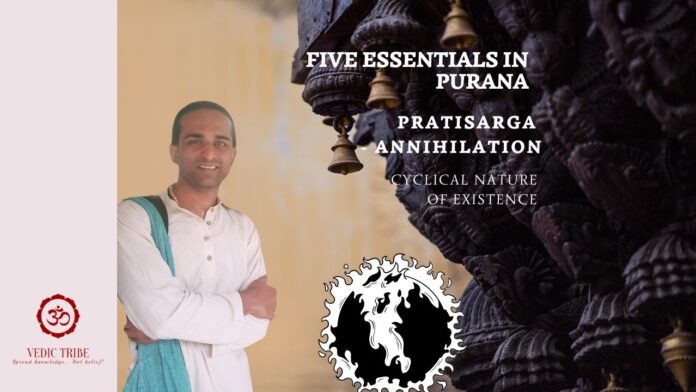Annihilation in Puranas:
In the previous article we discussed the common thread among Purana – “Sarga” (creationism) and in this article, we will discuss the common thread – “Pratisarga” (annihilation).
Puranas describe four types of annihilation:
1. Nitya (Constant Annihilation)
2. Athyantika (Liberatory Annihilation)
3. Naimittika (Occasional Annihilation)
4. Prakritika (Natural Annihilation)
Nitya (Constant Annihilation):
Life: This refers to the constant cycle of birth and death that all living beings experience. “Life,” in the Puranic perspective, arises when an individual consciousness (Atman) becomes entangled with matter (Prakriti). This entanglement leads to the experience of individuality, limitations, and the cycle of birth and death.
Death: It signifies the release of the individual consciousness from its current material form.
Annihilation: This continuous cycle of birth, life, and death is considered “Nitya” (constant) as it is an inherent aspect of conscious beings.
Athyantika (Liberatory Annihilation):
Liberation: This refers to the ultimate liberation of the individual consciousness from the cycle of birth and death. When the individual consciousness realizes its true nature, transcends the limitations of the material world, and units with the ultimate reality (Brahman), it attains “moksha” (liberation).
Annihilation: In this state, the individual consciousness is no longer subject to the cycle of birth and death. This is considered “Athyantika” (liberatory) as it signifies the end of the cycle of rebirth.
Naimittika (Occasional Annihilation):
Kalpa: This refers to the periodic dissolution of the universe at the end of each “Kalpa” (cosmic cycle). A Kalpa is a vast period of time, consisting of 1000 “Maha Yugas” (a cycle of four Yugas: Satya Yuga, Treta Yuga, Dwapara Yuga, and Kali Yuga).
Annihilation: At the end of a Kalpa, the entire universe undergoes a process of gradual dissolution, culminating in a state of inactivity and rest. This is considered “Naimittika” (occasional) as it occurs at specific intervals within the cosmic cycle.
Prakritika (Natural Annihilation):
Brahma: This refers to the complete dissolution of the universe at the end of a “Brahma’s day.” Brahma, the creator deity, is has a lifespan of 100 divine years.
Annihilation: At the end of Brahma’s lifespan, the entire universe undergoes a complete dissolution, returning to its primordial state. This is considered “Prakritika” (natural) as it is a natural consequence of the cosmic cycle and the lifespan of the creator deity.
Philosophy:
The Puranic accounts of Pratisarga are not merely mythological narratives. They delve into profound philosophical and spiritual concepts.
Transience: All the accounts have one common underlying code – i.e., our world is transient and we shall strive for eternal truth.
Kids play: For almighty its just a playfulness and we are here to enjoy such play
Awareness: We the individual consciousness have to search for the playful child and play with it. This awareness leads us to liberation.
Departure from Other Mythologies:
None of the Puranic narration of Pratisarga is found in stories told in Abrahamic religions. Instead, they provide a different proposition:
The end: They believe in a linear view of history, with a beginning and an end ordained by God.
The world’s dissolution is not a random event, but a part of God’s overarching plan.
The judgement: A central theme is a final judgment, where God will hold all of humanity accountable for their actions. This judgment precedes or coincides with the world’s end.
In conclusion:
The idea of annihilation in Puranas is intended to communicate the cyclical nature of cosmos and the role that we need to play in it. It is neither it is about the END of everything nor judgement. Instead, it stresses on impermanence of all things and the ultimate goal of liberation from the cycle of birth and death which is in our own hands subject to the compassion of almighty.
In our next article, we will discuss the common thread among Purana – “Vamsa”
Madhwesh K
Vedic Tribe

